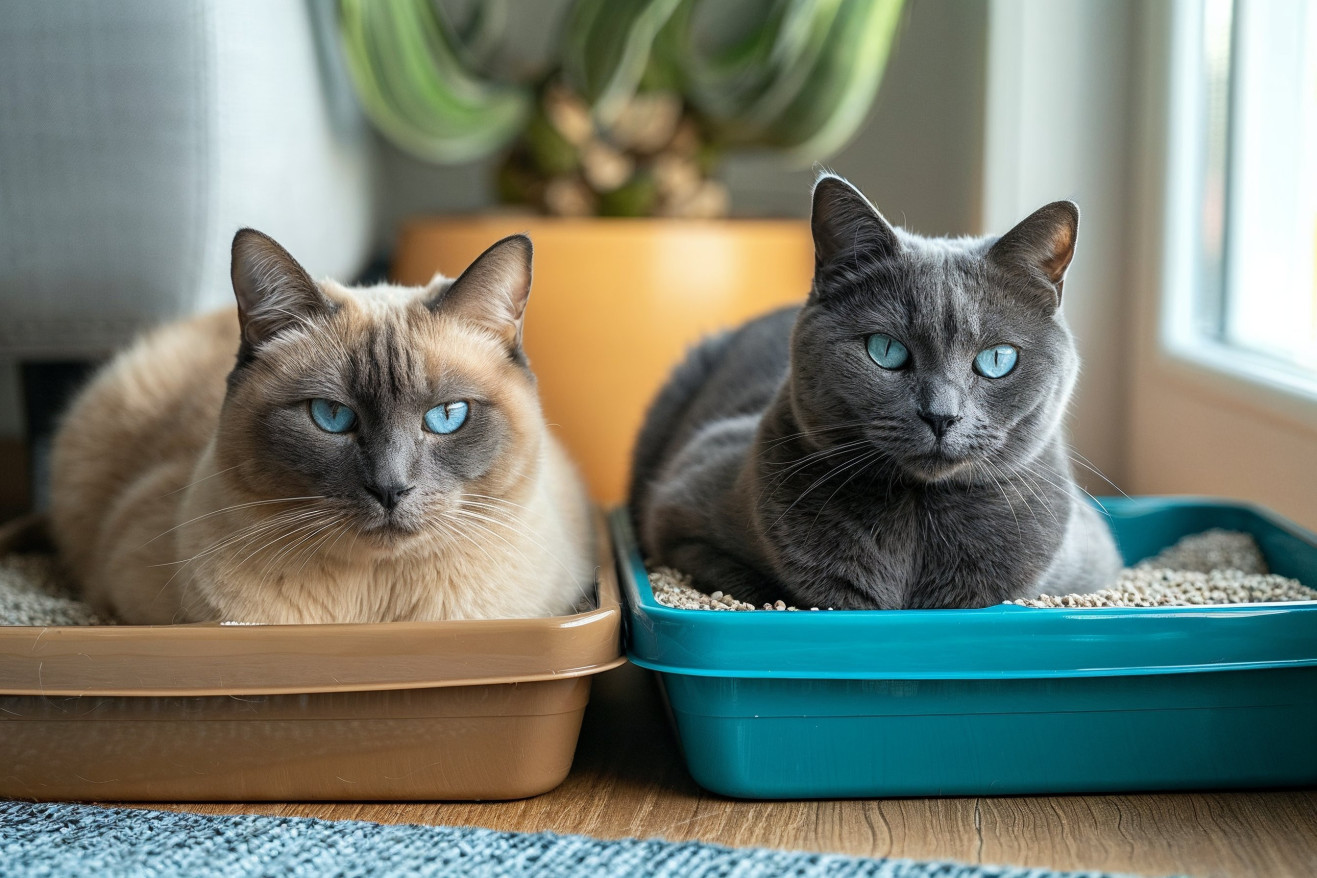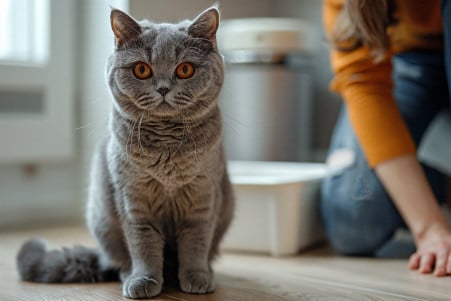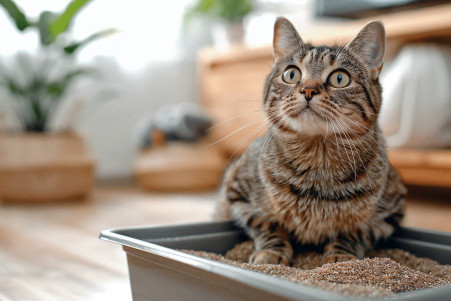Can Cats Share a Litter Box? Multi-Cat Litter Box Strategies
5 February 2024

When it comes to living with multiple cats, the key to success is often found in how well cats can share a space. This is especially true when it comes to litter boxes. While cats can share a litter box, it is not recommended. Most experts suggest one litter box per cat with an extra box to help reduce stress and territorial behaviors.
That said, the more litter boxes the better, especially when it comes to keeping a clean environment for cats.
This article will take a deep dive into the veterinary, behavioral, and environmental factors that go into cats sharing litter boxes. It will also look at how cats’ living situations can affect their ability to share litter boxes.
This includes expert opinions on cat behavior, the health effects of litter box sharing, and how the design of a litter box can affect a cat’s willingness to use it. Understanding these factors can help ensure a happy living situation for cats in a multi-cat household and help keep cats healthy.
Can cats share a litter box?
Managing Territory in Multi-Cat Homes
Cats are territorial animals, and this territorialism even extends to their litter boxes. Sharing a litter box can be seen as a direct challenge to a cat’s territorial nature and can lead to stress and behavioral issues. According to Fear Free Happy Homes, when cats are forced to share a litter box, it can create a sense of competition and conflict that can lead to issues like litter box avoidance and marking.
The idea of ‘time-sharing’ also offers insight into how cats naturally handle territory. In the wild, cats will take turns using communal spaces to avoid conflict. In the home, this means that if you provide enough litter boxes, cats can take turns using them, which can reduce stress.
In fact, one of the best ways to reduce territorial conflicts is to provide enough litter boxes so that cats can use them on their own schedules, which reduces the likelihood of conflict.
In general, experts recommend that cat owners take the time to understand things from their cats’ point of view and make sure that litter boxes are clean and inviting to reduce conflicts.
In addition, regular cleaning and the strategic placement of litter boxes can help cats coexist peacefully. In the end, understanding cat behavior and the importance of territory can help cat owners create a home that encourages cats to use the litter box as they should.
Health Risks of Shared Litter Boxes
While the convenience of fewer litter boxes may be tempting, it can pose serious health risks to your cats. Sharing a litter box increases the likelihood of spreading infections between cats. Anasazi Animal Clinic explains that dirty litter boxes can cause serious health problems like kidney infections, bladder infections, bladder stones, and urinary tract infections. The stress caused by the waste buildup in the litter box can make these conditions worse.
Litter box cleanliness is critical to the health of cats in a multi-cat household. At a minimum, litter boxes should be scooped once a day, and for multi-cat households, twice-daily scooping is recommended. Litter boxes should be cleaned regularly to prevent the buildup of bacteria.
Cat owners can reduce the risk of health problems by maintaining a strict cleaning schedule and ensuring that each cat has its own litter box, plus one extra for communal use. Keeping the litter boxes clean isn’t just about cleanliness, it’s a way to prevent health problems and ensure your pets stay healthy and happy.
Understanding the Impact of Litter Box Design on Cat Behavior
The design of the litter box has a big impact on cat behavior and preferences. For example, a 2013 study showed that cats don’t have a strong preference for covered vs. uncovered litter boxes, but individual cats may have their own preferences, such as a desire for more privacy or a preference for an uncovered box.
The size of the litter box is also important, especially for larger cats, who need more room to move around.
Automatic litter boxes, while convenient for cat owners, may not be used by cats because of the noise and movement they make. The type of litter used in the box is also important. A study published on PMC found that cats preferred plant-based clumping litter with an attractant to regular plant-based clumping litter, showing that the right litter can make a big difference in whether or not a cat uses the box.
The number of litter boxes in a home should also be based on the number of cats in the home to meet individual needs and reduce territorial conflicts. Meeting the needs of individual cats with the right litter box design can make a big difference in the overall peace of a multi-cat household.
Cat Personalities and Their Impact on Litter Box Sharing
Like people, cats have individual personalities that affect their behavior, including their willingness to share resources like litter boxes. A study in PMC notes the similarity between owner personalities and cat behavior, suggesting that people with higher levels of neuroticism may have cats that show more stress-related behaviors, which can lead to a lower willingness to share litter boxes.
Meanwhile, owner conscientiousness and agreeableness were linked to positive cat lifestyles and behaviors, which could lead to a more cooperative litter box-sharing environment.
A cat’s sociability also determines how willing they are to share a litter box. A study in the Journal of the American Veterinary Medical Association by Salla Mikkola found that cats with lower sociability toward other cats were more likely to engage in house soiling and litter box issues. This shows that a one-size-fits-all approach to litter box management won’t work and that individual cat personalities need to be taken into account.
This means that a personalized, strategic approach to litter box placement and management is needed to account for these different feline personalities. By taking into account the personalities of both the cat and the owner, we can come up with a litter box plan that reduces stress and creates a more peaceful multi-cat home.
How to Set Up Litter Boxes in a Multi-Cat Household
Setting up a multi-cat household for success when it comes to litter boxes requires some planning. PetMD notes that the most important thing to remember is to make sure there are enough litter boxes for all of your cats, plus one extra. This will help prevent territorial issues and ensure that no cat feels the need to guard the litter box. Other things to keep in mind include:
Strategic Box Placement: Make sure to place the litter boxes in different locations around your home. These areas should be low-traffic and quiet to ensure that no cat can guard all of the litter boxes and that no cat can be ambushed while using the box.
Introducing New Cats: Vetstreet suggests that when you bring a new cat home, you set up a “safe room” for them that includes a litter box. This will help the cat get used to their own space before they have to start sharing with other cats.
Health and Behavior Monitoring: Pay attention to your cats’ litter box habits. If you notice any changes in their behavior, it could be a sign of a health issue or a sign that they’re not happy with the current litter box setup.
Maintaining Cleanliness: Make sure to clean the litter boxes regularly, at least once a day, and do a deep clean every so often to make sure that you’re preventing odors and diseases. This is especially important in multi-cat households.
By doing these things, you can make sure that you’re creating an environment that’s as stress-free as possible for your cats and that you’re also supporting their health.
Navigating the Litter Box Landscape: A Roadmap for Multi-Cat Households
To successfully manage a multi-cat household, it’s important to take a mindful approach to one of the most important aspects of a cat’s daily life: the litter box. As outlined, providing each cat with their own litter box and then adding one additional box is essential to keeping the peace and keeping things clean.
This will help reduce stress, avoid territorial conflicts, and maintain the health of your cats by reducing the spread of disease.
Cleanliness goes beyond just scooping and changing the litter; it also means choosing the right box and litter type based on your cats’ individual preferences. Recognizing that each cat has its own unique personality and temperament will help you better manage shared resources, which will ultimately lead to a more successful cohabitation.
In conclusion, the happiness of cats in a multi-cat household is dependent on respecting their individual needs and keeping a clean, stress-free litter box environment. By integrating these concepts into your litter box management, you can help ensure that your feline family members are happy, healthy, and coexisting peacefully.


